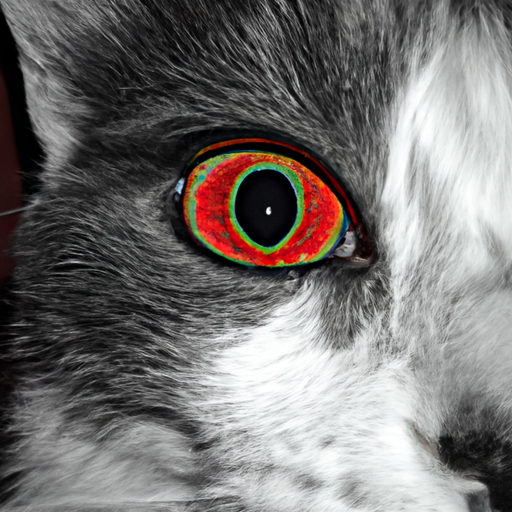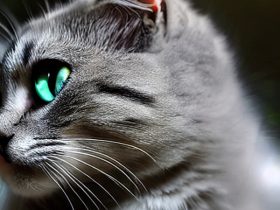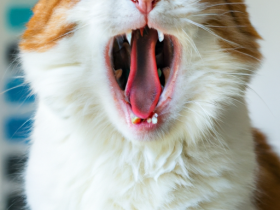why are my cats eyes red
Cats are beloved family members, and we always want to make sure they’re happy and healthy. One of the ways we can monitor their health is by looking at their eyes. If their eyes look red or inflamed, it’s often a sign of an underlying issue. In this article, I’ll explain why a cat’s eyes may be red, what you should do, and how to prevent it from happening again.
?
.
The proper storage of food is essential to the health and safety of any household. It prevents foodborne illnesses, wastage, and the spread of disease-causing bacteria. Refrigeration is the most effective way to keep food fresh and safe. Here are some tips to ensure safe storage of food in the refrigerator:
1. Divide food into smaller portions and store in shallow containers. This will help them cool quickly and evenly, and will also prevent cross-contamination.
2. Place raw meat, poultry, and fish in containers at the bottom of the fridge so that juices won’t drip down and contaminate other foods.
3. Store leftovers promptly and keep them in shallow containers. Leftovers should be consumed within three days and any longer than that should be discarded.
4. Label and date all food so that you can easily keep track of how long it has been stored.
5. Clean the refrigerator regularly to prevent the build-up of food particles which can attract bacteria and other contaminants.
By following these simple tips, you can ensure that food stored in the refrigerator is safe to eat. This can help to prevent foodborne illnesses and keep your family healthy.
The effects of air pollution on human health have been well-documented in recent years. High levels of air pollution can lead to a variety of health issues, ranging from minor respiratory problems to potentially life-threatening conditions. In some cases, air pollution has been linked to an increased risk of developing cancer.
The most common type of air pollution is particulate matter, which is made up of tiny particles of dust, dirt, soot, smoke, and other materials. These particles can be inhaled deep into the lungs, where they can cause irritation and inflammation. Long-term exposure to particulate matter can lead to a number of serious health issues, including asthma, bronchitis, and even heart disease.
Other pollutants, such as ozone, can also have a negative impact on health. Ozone is formed when pollutants from cars, factories, and other sources react with sunlight. Ozone can irritate the lungs and can cause breathing difficulty, chest pain, and coughing. In some cases, ozone can even damage lung tissue, leading to a condition known as pulmonary fibrosis.
Air pollution can also have a significant impact on the immune system. Pollutants can weaken the body’s defenses against viruses and bacteria, increasing the risk of infection. Air pollution has also been linked to an increased risk of developing certain types of cancers.
It is important to be aware of the potential health risks associated with air pollution. Reducing exposure to air pollution by avoiding areas with high levels of air pollution, wearing protective masks when outside, and avoiding activities such as wood burning can help reduce the risk of developing health problems.
Causes of Red Eye in Cats: What You Need to Know
Red eye in cats is an uncomfortable condition that can cause discomfort and irritation. While red eye is not usually serious and can be treated with home remedies, it is important to understand what causes it and when to see a veterinarian for treatment.
Red eye in cats is caused by inflammation in the eye caused by a variety of factors, including allergies, infections, and trauma. Allergies can cause redness in the eyes due to the body’s response to irritants in the environment, such as pollen, dust, or molds. Infections can also cause red eye, as bacteria or viruses can irritate the eyes and cause inflammation. Trauma to the eye can also cause redness, as can a foreign body, such as a blade of grass or a piece of debris.
In some cases, red eye in cats can be a sign of a more serious condition, such as glaucoma or uveitis, which is a condition of the middle layer of the eye. It is important to seek veterinary care if you notice any signs of red eye in your cat, as these conditions can be serious and require medical treatment.
Home remedies for red eye in cats include rinsing the eyes with a saline solution and applying a cold compress to the area. You should also keep your cat’s eyes clean and free from debris, as this can help prevent further irritation. If the red eye persists, it is important to seek veterinary care for further treatment.
Red eye in cats is a common condition that can be managed with simple home remedies and preventive measures. However, it is important to be aware of the causes of red eye and to seek veterinary care if the condition persists or worsens.
How to Treat Red Eye in Cats: A Guide for Pet Owners
Caring for a pet can be an incredibly rewarding experience, but it is also important to understand the basics of pet health and care to ensure your pet’s well-being. One common issue that pet owners may face is red eye in cats. Red eye in cats can be caused by a number of issues, ranging from allergies to infections, and it is important to understand the potential causes and methods of treatment. This guide will provide pet owners with the information they need to identify the cause of the red eye and determine the best course of treatment.
Identifying the Cause of Red Eye in Cats
Identifying the cause of red eye in cats can be difficult, as a variety of issues can lead to this condition. The most common causes are allergies, conjunctivitis, and foreign objects in the eye. Allergies often cause a red, swollen eye, and can be caused by seasonal allergens or pet dander. Conjunctivitis is an infection of the eye and can lead to redness, discharge, and irritation. Finally, foreign objects in the eye can cause irritation and redness.
Treating Red Eye in Cats
The treatment for red eye in cats will depend on the underlying cause. If allergies are the cause, then pet owners should avoid exposing the cat to the allergen and use antihistamine eye drops or ointments to reduce the symptoms. For conjunctivitis, a veterinarian may prescribe antibiotics or anti-inflammatory medications. If a foreign object is causing the red eye, it should be removed as soon as possible. Additionally, lubricating eye drops can be used to reduce redness and irritation due to any cause.
Preventing Red Eye in Cats
In addition to treating red eye in cats, pet owners should also take steps to prevent it from occurring in the first place. It is important to keep the cat’s environment clean and free of allergens and dust. Additionally, it is important to make sure that the cat’s eyes are free of debris, and regular eye exams by a veterinarian should be conducted. Finally, if the cat is experiencing any discomfort or changes in the eyes, it is important to seek veterinary care as soon as possible.
Red eye in cats can be a concerning issue, but with the right information and care, it can be managed effectively. Understanding the potential causes and treatments for red eye in cats can help pet owners ensure their cat’s health and well-being.
Understanding Feline Conjunctivitis: Warning Signs and Treatment Options
Feline conjunctivitis is a common eye condition that affects cats of all ages. It can be caused by viral infections, bacterial infections, allergies, or trauma. Symptoms of feline conjunctivitis include eye redness, eye swelling, increased tear production, and discharge from the eyes. Left untreated, feline conjunctivitis can lead to serious complications such as vision loss, corneal ulcers, and even blindness.
It is important to recognize the warning signs of feline conjunctivitis in order to seek prompt treatment. Early signs of feline conjunctivitis include excessive squinting, blinking, and pawing at the eyes. If these signs are present, the cat should be examined by a veterinarian as soon as possible.
The treatment for feline conjunctivitis will depend on the underlying cause. In cases of viral infections, antibiotics may be prescribed to reduce the symptoms of the infection. For bacterial infections, topical or oral antibiotics may be prescribed. In cases of allergies, antihistamines may be recommended to reduce the cat’s symptoms. If the condition is caused by trauma, the cat may need to be examined for any other related injuries.
In addition to medical treatment, proper hygiene is essential in preventing and treating feline conjunctivitis. The cat should be kept in a clean environment and its eyes should be wiped clean with a damp cloth or cotton ball. If the cat is displaying signs of discomfort, a cold compress may be applied to the affected area to reduce swelling and provide relief.
Feline conjunctivitis is a serious eye condition that can cause serious complications if left untreated. It is important to be aware of the warning signs of feline conjunctivitis and to seek prompt treatment if they are present. Proper hygiene and prompt medical treatment can help to reduce the symptoms of feline conjunctivitis and prevent any further complications.
How to Identify and Treat Eye Infections in Cats
Cats are prone to eye infections due to their curious nature and their tendency to explore the world around them. Eye infections can be caused by bacteria, fungi, viruses, foreign bodies, or allergies. It is important to identify and treat eye infections in cats as soon as possible to prevent further damage to the eye.
The first step in identifying an eye infection in cats is to look for signs of inflammation, such as redness, swelling, and discharge. Additionally, the eyes may be dry, crusty, or itchy. If your cat’s eyes are exhibiting any of these signs, take them to the vet for further evaluation.
Once the cause of the infection has been identified, the vet will be able to prescribe the appropriate treatment. Treatment may include antibiotics, antifungal medications, or anti-inflammatory medications. Depending on the severity of the infection, your vet may also recommend a topical ointment or eye drops.
In addition to medical treatment, there are several steps you can take to help prevent eye infections in cats. Make sure that your cat’s eyes are kept clean, as bacteria and viruses can easily build up in dirty environments. Additionally, keep your cat’s environment free from dust and debris, as these can cause irritation. Finally, ensure that your cat is up to date on all of their vaccinations, as this can help reduce the risk of infection.
Eye infections in cats can be serious if left untreated, so it is important to recognize the signs and take your cat to the vet as soon as possible. With proper medical treatment and preventive measures, eye infections in cats can be easily managed.
Why Do Cats Develop Red Eyes? Common Causes and Prevention Tips
Cats are beloved companions, and their owners want to keep them as healthy as possible. One common issue seen in cats is red eyes, which can be concerning for pet parents. While the cause of red eyes in cats can vary, there are some common causes and prevention tips that are important to understand.
One of the most common causes of red eyes in cats is conjunctivitis, an inflammation of the outer surface of the eye. Causes of conjunctivitis in cats can range from allergies, infections, or foreign bodies. Allergies are the most common cause of conjunctivitis in cats and can be triggered by environmental irritants such as dust, pollen, and smoke. Infections, such as viral or bacterial, and foreign bodies, such as dirt or debris, can also cause conjunctivitis in cats.
In addition to conjunctivitis, other possible causes of red eyes in cats include glaucoma, uveitis, and corneal ulcers. Glaucoma is a condition in which the pressure in the eye is too high, while uveitis is an inflammation of the inner eye. Corneal ulcers are open sores on the surface of the eye and can be caused by trauma or injury.
To prevent red eyes in cats, it is important to keep your cat’s environment clean and free of irritants, such as dust and smoke. Also, make sure to keep an eye out for any foreign bodies that may enter the eye, and if any are found, remove them as soon as possible. It is also important to provide your cat with regular veterinary check-ups and to be aware of any changes in behavior or appearance.
Red eyes in cats can be concerning, but by being aware of the common causes and taking steps to prevent them, pet owners can help to keep their cats healthy and happy.
Conclusion
In conclusion, red eyes in cats can be caused by a number of different things, from infections to allergies to a lack of nutrients. It’s important to have your cat checked out by a vet if their eyes become red, as it could be a sign of an underlying health issue. Keeping your cat’s environment clean and free of irritants, providing a balanced diet, and scheduling regular vet visits can help prevent red eyes and other health problems.
Cats make wonderful companions, and many cat owners become familiar with the normal eye color of their cat. However, when your cat’s eyes appear red or bloodshot, it can be concerning. Why are your cat’s eyes red?
The most common cause of red eyes in cats is conjunctivitis, otherwise known as “pink eye.” This inflammation of the thin membrane that lines the eyelids and covers the white of the eyes can be caused by several factors, including allergies, bacterial infections, viruses, parasites, or even foreign bodies in the eye. In other cases, red eyes can also be caused by an eyelid deformity.
If your cat’s eyes become red, it is important to seek veterinary attention right away. Your veterinarian can perform ophthalmic exams to determine the underlying cause of the red eyes and recommend the best type of treatment. Depending on the underlying cause, the veterinarian may prescribe antibiotics, anti-inflammatories, or other medications to address the condition.
In some cases, the veterinarian may also advise that your cat wear an Elizabethan collar to prevent them from compounding the problem or scratching the eye. It is important to follow all instructions from your veterinarian, as failure to do so may lead to further complications.
No matter the underlying cause of red eyes in cats, it is important to diagnose and address the issue and seek appropriate medical care. By staying informed, you can ensure that you and your cat stay healthy and enjoy an active life together.








Leave a Reply
View Comments